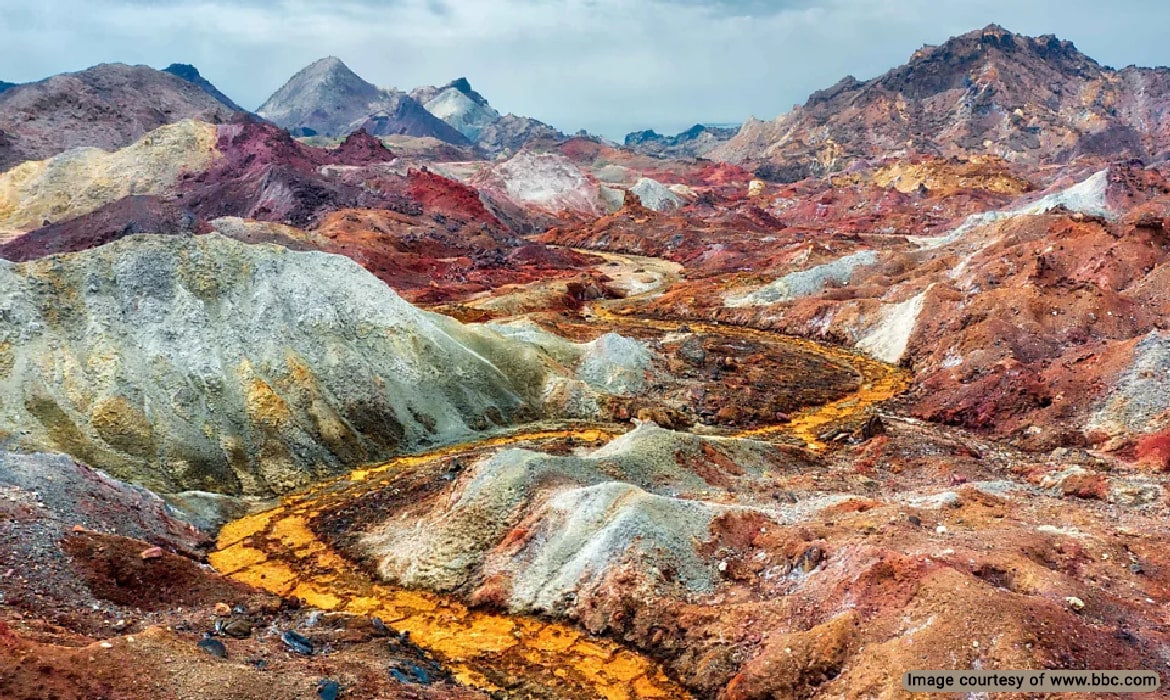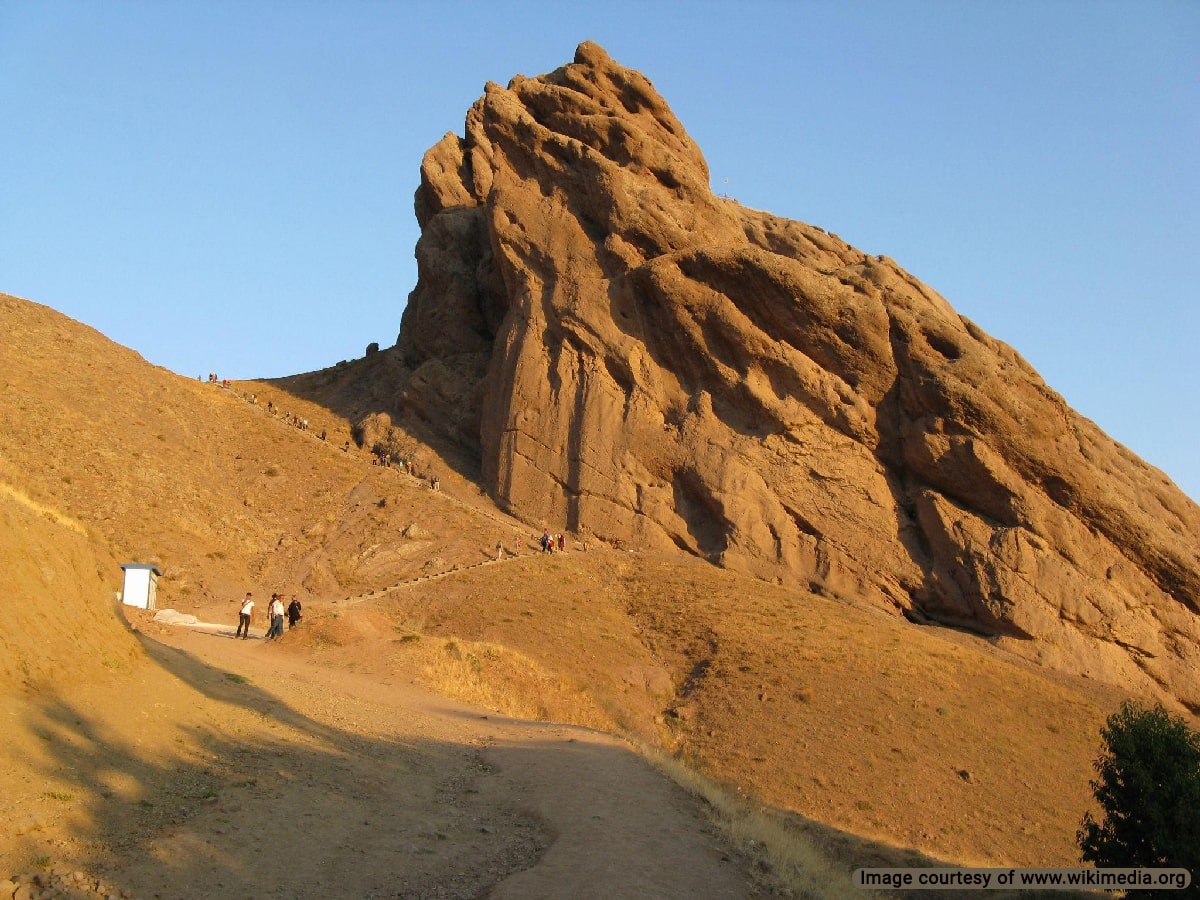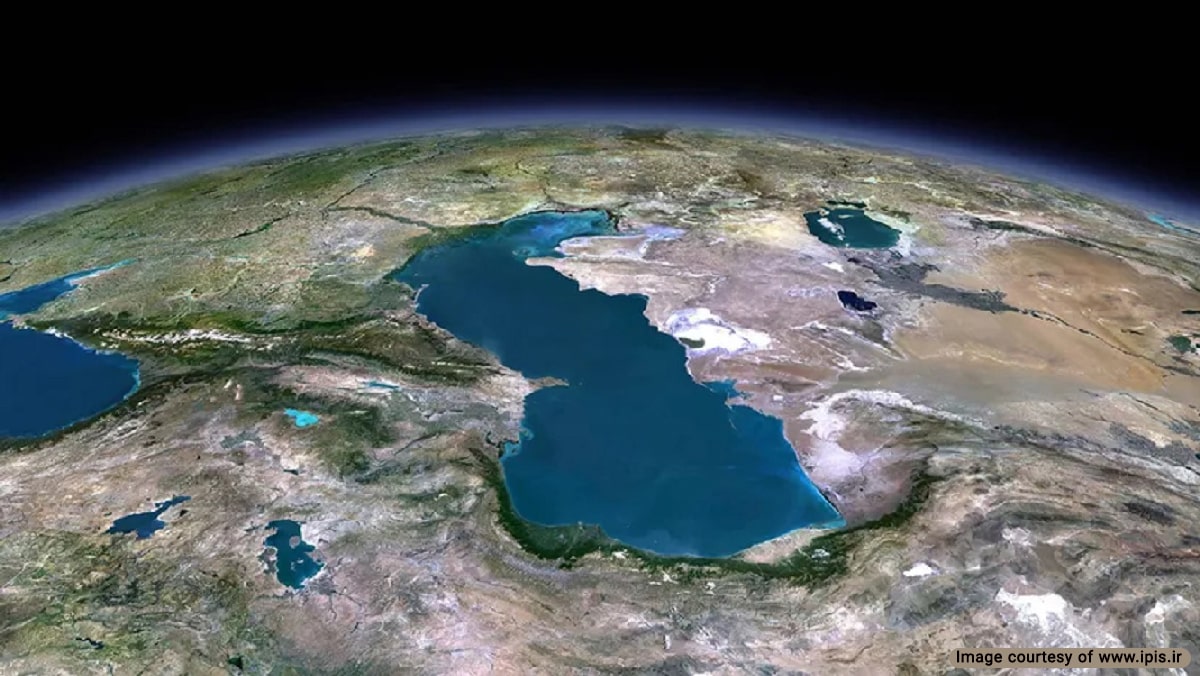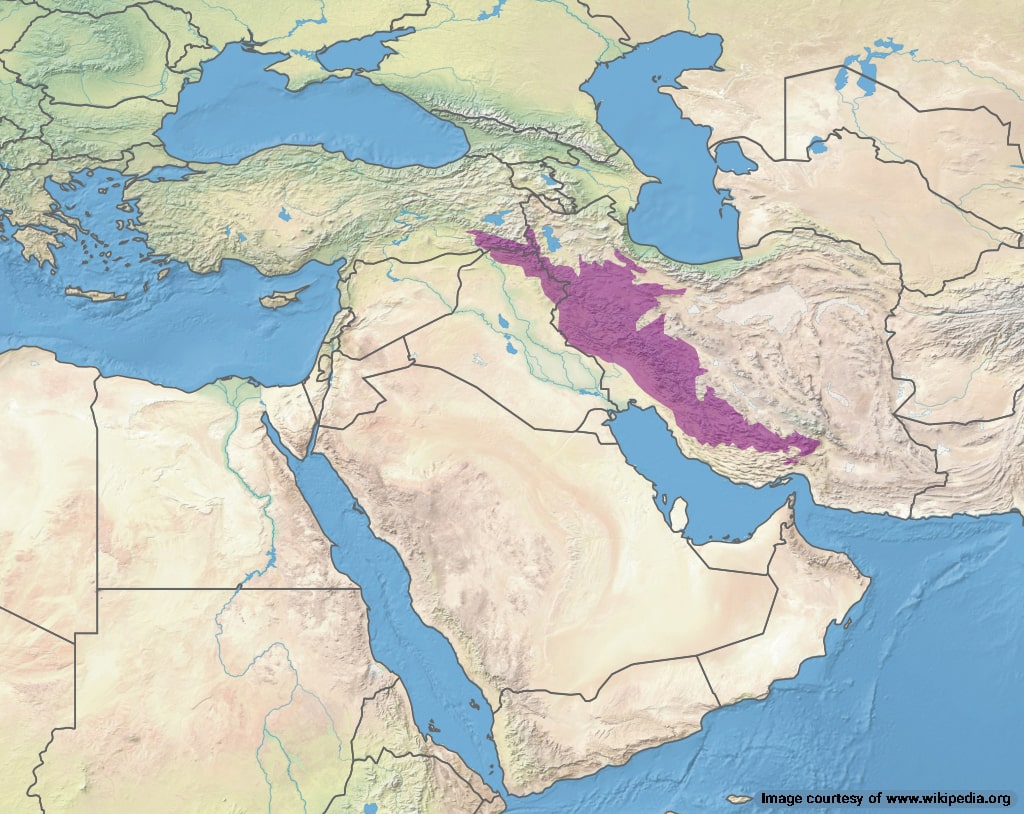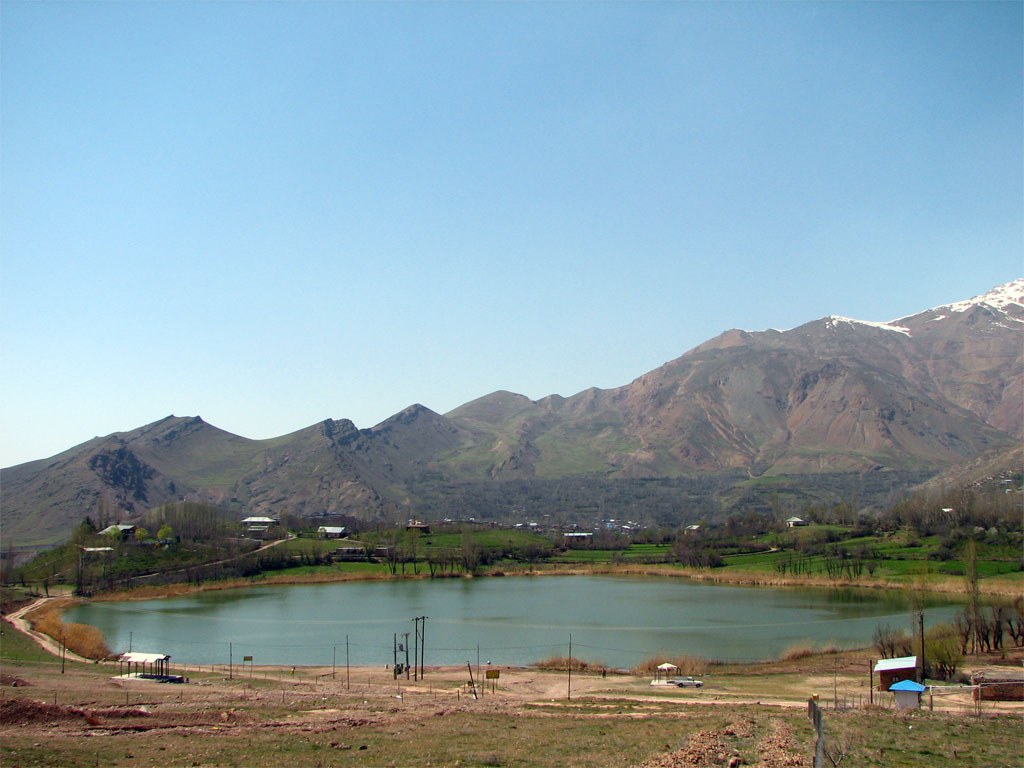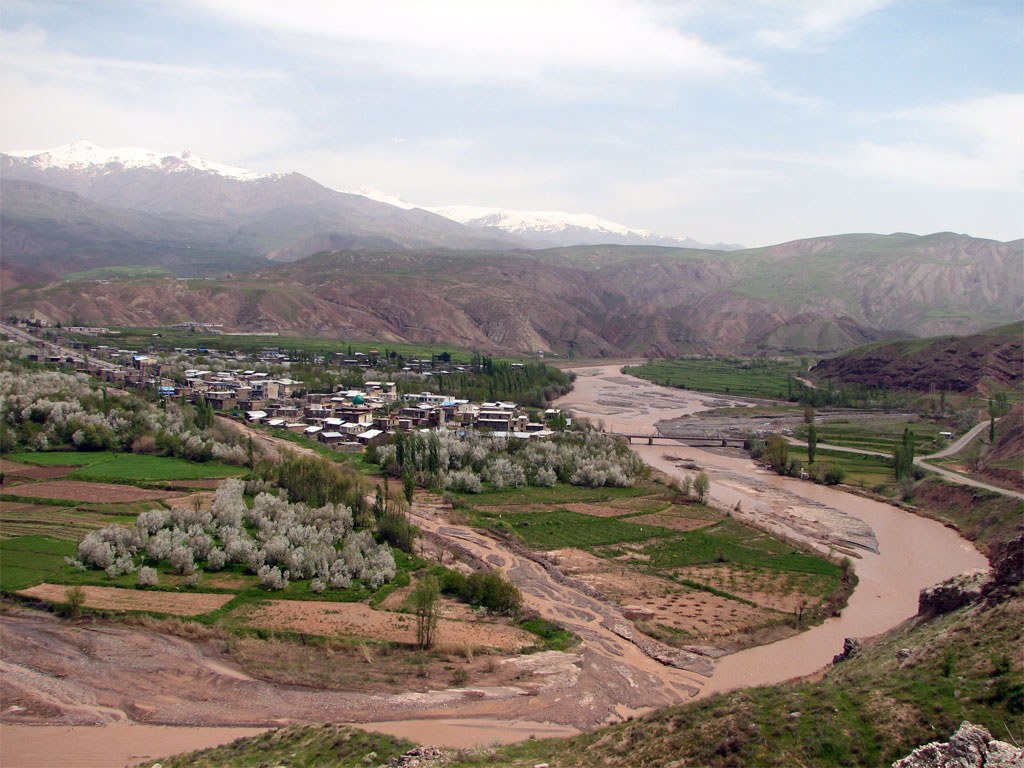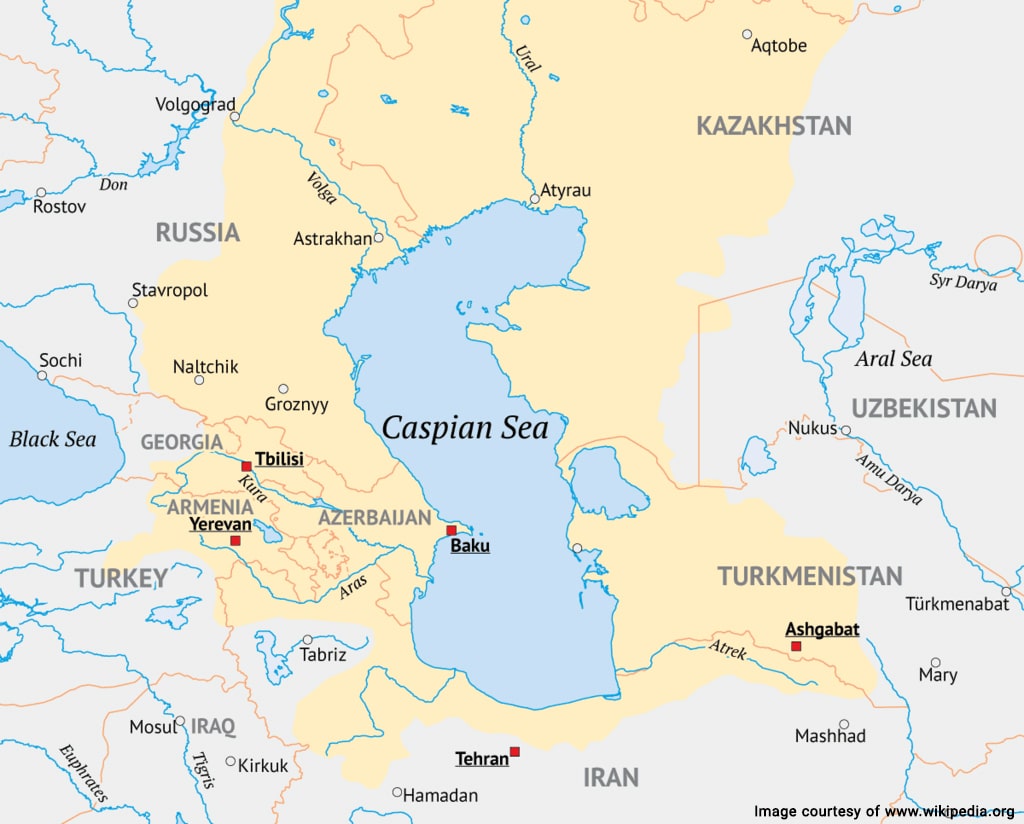
The Caspian Sea (Khazar, Mazandaran Sea) is the largest lake in the world in terms of surface area. Despite the lack of connection to any ocean in modern times, it is called a sea in most sources because of its sheer size. It covers an area of 371,000 km² with a maximum length of over 1,000 km and a width of 435 km. It has an average depth of 211 meters and a maximum depth of 1,025 meters. The Caspian Sea is one of the most important landmarks in the geography of Iran.
Formation of the Caspian Sea
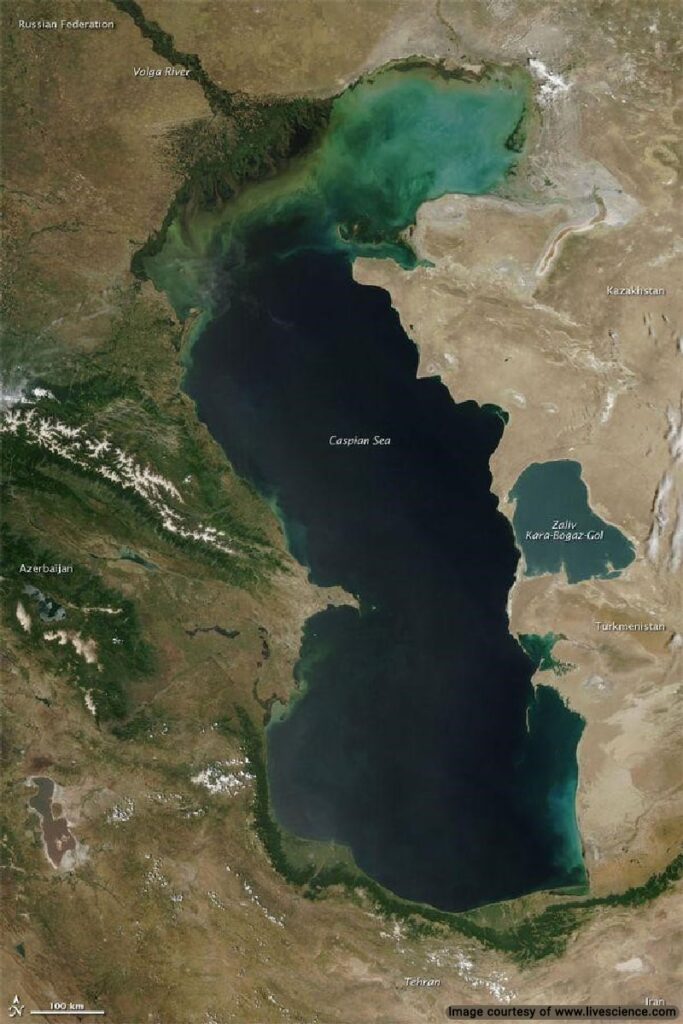
The estimated formation of the Caspian Sea occurred 30 million years ago during the Oligocene period. It is a remnant of the Parathethys Sea along several other bodies of water such as the Black Sea, Aral Sea, Urmia Lake, Namak Lake, and more. Therefore, the Caspian seafloor is an oceanic Basalt floor, formed by Mafic minerals composed of plagioclase, amphibole, and pyroxene.
The tectonic shifts in the Late Miocene period caused a drastic drop in sea levels, which landlocked this basin. In the following Pliocene period, the Caspian Sea shrank to about one-fifth of its current surface area. In the hot climate of the Holocene Epoch, this body of water evaporated, creating halite deposits. This led to an increase in salt content in the basin.
Caspian Sea Geography
The Caspian Sea is limited by the Southern Russian plains in the north, the Volga Delta in the northwest, the Central Asia Steppe in the eastern shores, the Iranian plateau in the south, and the Caucasus mountains in the west.
The Caspian Climate varies in different areas. The northern coasts feature a cold desert climate, cold semi-arid climate, and humid continental climate. The southern coasts have a humid subtropical and Mediterranean climate.
The Caspian Sea is a collection of three basins. The northern basin is the smallest (91,000 km2) and most shallow (maximum 25 meters). The total volume of the northern basin is 0.5% of the sea’s total volume. The central basin covers an area of 137,000 km2 with a maximum depth of 788m meters. It accounts for nearly 34% of the total volume. The southern basin is the largest with a surface area of 148,000 km2 and a maximum depth of 1,025 meters. It accounts for 65% of the total volume of the sea.
The shores cover the borders of Russia (Northwest), Kazakhstan (Northeast), Turkmenistan (Southeast), (Azerbaijan (Southwest), and Iran (South). Kazakhstan has the largest shoreline (1,900 km), followed by Turkmenistan (1,768 km), Russia (1,355 km), Azerbaijan (820 km), and Iran (657 km). Iran has the smallest shoreline with the Caspian Sea accounting for nearly 10%. Before the dissolution of the USSR, Iran and the USSR were the only states with access to the sea.
Caspian Sea Salinity
The Caspian Sea has an average salinity of 1.2% (about 12.8 parts per thousand), around one-third of average ocean salinity. However, the range of salinity levels in the Caspian varies based on evaporation and freshwater inflow. Salinity is much lower (1 part per thousand) near the Volga Oulet, where the Volga River flows into the sea near the Russia-Kazakhstan border. The salt levels are much higher in the southern and eastern shores. The Garabogazköl lagoon to the east of the sea exhibits extremely high salinity levels of 35%. In comparison, average oceanic salinity is 3-4%.
Caspian Islands
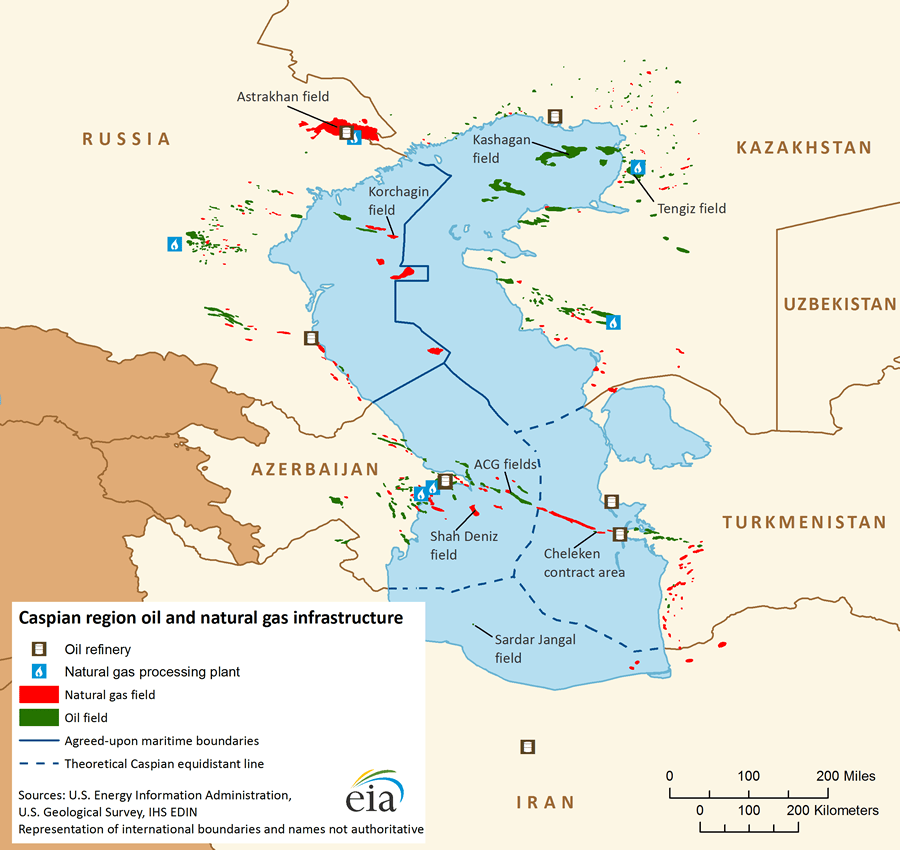
There are about 50 islands in the Caspian Sea that cover 350 square km.
Azerbaijan
Baku Archipelago: A series of islands on the west coast of the Caspian Sea including Boyuk Zira (Nargin) Island, Das Zire (Vulf), Qum Island, and Tava (Plita) Island.
Pirallahi Island: It is the largest island of Azerbaijan in the Caspian Sea with a total area of 14.6 km.
Chilov Island: It is located to the east of the Absheron Peninsula in the Caspian Sea and it is uninhabited. Its total area is 12 km.
Azerbaijan has claimed several other small islands in the region including Sangi Mugan or Svinoy
Zenbil (Duvanni), Chikil (Oblivnoy), Qara Su (Los), Xara Zira (Bulla), Qutan and Baburi Islands (Podvodnyye), Adsiz Ada, Dasli Ada (Bezymyannyy), Gil (Glinyanyy), Kura Island (Kurinsky), Kura Rock (Kurinsky Kamen)
There are also two artificial islands created by Azerbaijan. The first offshore oil platform in the world is called Neft Daşları, and a stalled project called Khazar Islands that consists of 41 islands, spanning over 30 km2.
Kazakhstan
Tyuleny Archipelago: It is a collection of islands on the northeastern shores including Kulaly, Morskoy, Rybachy, Podgornyy, and Novyy.
Bolshiye Peshnyye Islands: Two small islands on the northern coast.
Durneva Island is an island near the coast of the Dead Kultuk.
Spirkin Oseredok Island: It is located near the inflow point of the Volga River on the northern coast.
Zhanbay Island (Zhanbay Aral): Another island near the mouth of the Volga River in the north.
Russia
Tyuleniy Island: It is located in the northeast part of the Caspian Sea. The island is 68 km² in size and belongs to the Republic of Dagestan.
Chechen Island: It is located in the northwest of the Caspian Sea. The island is 55 km² in size and belongs to the Republic of Dagestan.
Turkmenistan
Ogurja Ada Island (Ogurchinskiy): It is the largest island in the Caspian Sea, located in the southeast of the sea. The island’s surface area is 45 km.
Iran:
Ashuradeh Island: It is the only island of Iranian territory in the Caspian Sea. The surface size is 800 hectares and is located in the southeast of the sea. It is part of Mazandaran province.
Caspain Rivers
The following rivers flow into the Caspian Sea from several regions:
- Volga, Terek, Sulak, Kura, Khasavyurt (Russia)
- Ural (Russia, Kazakhstan)
- Samur (Russia, Azerbaijan
- Gorgan, Sefid Rud, Atrak
The Caspian Sea has no natural outflowing rivers and only discharges the inflow of water through evaporation.
Caspian Wetlands
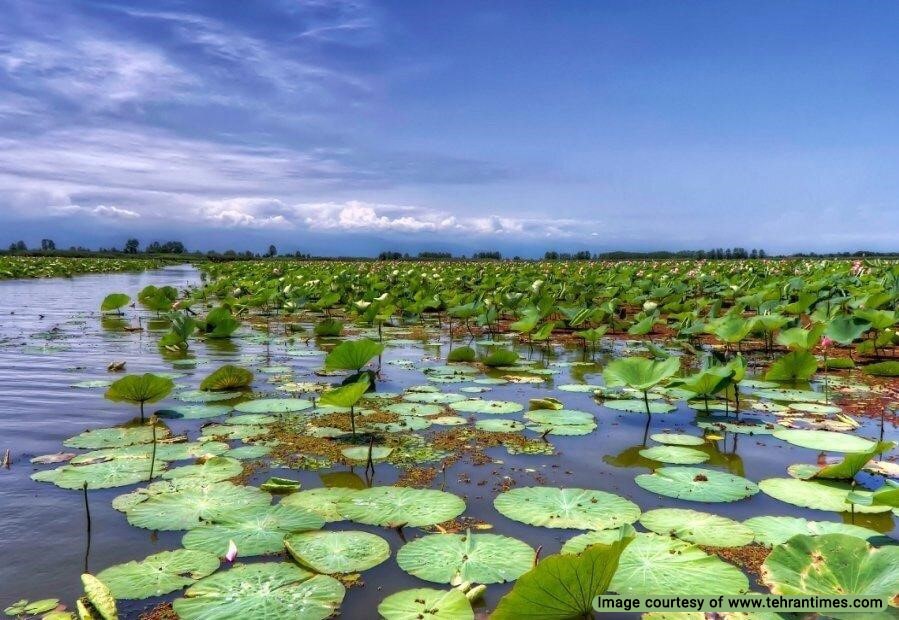
There are several lagoons surrounding the Caspian shores that house endangered endemic flora and fauna species, including
- Miankaleh Lagoon: A UNESCO-recognized Biosphere Reserve located on the southern coast of the sea in Iran
- Anzali Lagoon: This marshland is located near Bandar-e Anzali in Iran
- Sarygamysh Lagoon: This wetland is located on the eastern coast of Turkmenistan
- Atrek Lagoon: Located on the northeastern shores of Turkmenistan
- Kizlyar Bay: Located on the Western Coast of Russia, with a lagoon-like biome
- Khazar Lagoon: Located in Azerbaijan, on the eastern shores of the Caspian Sea
- Siazan Lagoon: Located in Siazan Town on the western coast of Azerbaijan
- Neftchala Lagoon: Located in a region of the same name on the southeastern shores of Azerbaijan
- Khasan Lake: is another wetland near the Caspian Sea in Russia
- Garabogazköl Lagoon: a shallow and highly saline wetland on the eastern coast, in Turkmenistan. This lagoon is separated from the sea by a rocky ridge.
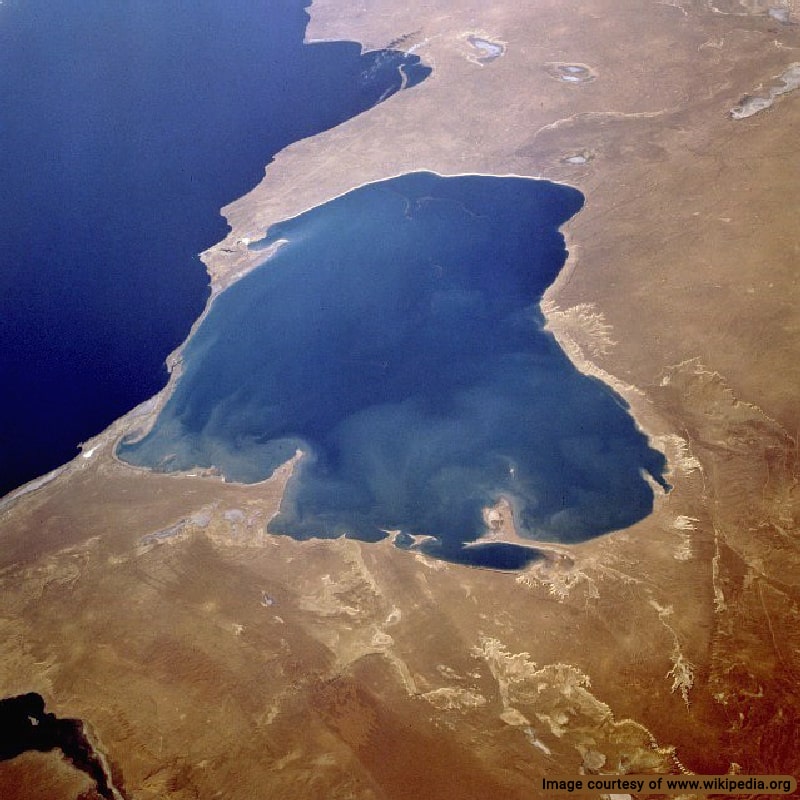
Caspian Sea Marine Life
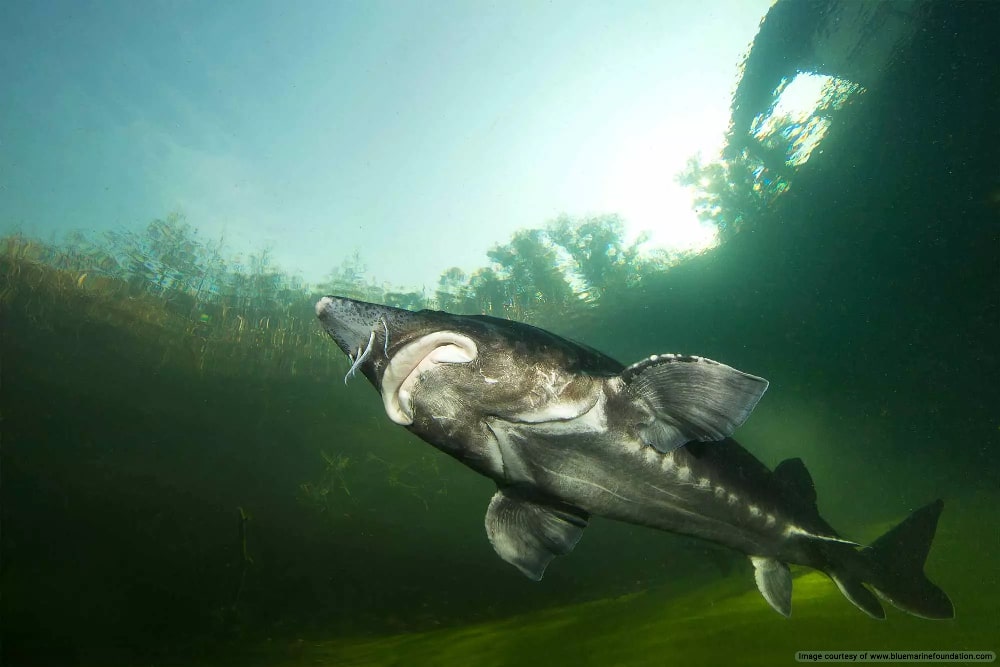
Considering its size, the biodiversity of marine life in the Caspian Sea is rather low. Some of these species are endemic (native to the Caspian Sea and only found there). A total of 1,814 species have been identified in this biogeographic region. This number includes 100 species of fish, while the majority of identified species are invertebrates.
Caspian Flora
There are over 500 plant species in the region which is another sign of low biodiversity in this biome. Several species of algae constitute the highest biomass concentration. Other prevalent flora in the Caspian Sea include Common Reed (Phragmites australis), Tamarix (Tamarix spp.), Sea Buckthorn (Hippophae rhamnoides), Caspian Sea Buckthorn (Hippophae rhamnoides subsp. turkestanica), Caspian Lotus (Nelumbo caspica), Astragalus (Astragalus spp.), Salicornia (Salicornia spp.), Eelgrass (Zostera marina), and Sea Lavender (Limonium spp.).
In addition, there are several forest areas along the Caspian shores, including the Hyrcanian forests, tidal regions of the Volga Delta, and the Samur River riparian forests. These biomes are home to endemic plant species, some of which date back to prehistoric periods. The following species can be found in the forest areas:
Oriental beech (Fagus orientalis), Persian ironwood (Parrotia persica), Caucasian wingnut (Pterocarya fraxinifolia), Caspian locust (Gleditsia caspica), Caspian maple (Acer cappadocicum), Caspian Mulberry (Morus alba var. caspica), Caspian Laurel (Laurus nobilis subsp. iberica), Caspian Yew (Taxus baccata subsp. cuspidata)
The wetlands and steppe surrounding the sea are home to other flora such as:
Common reed (Phragmites australis), Water lilies (Nymphaea spp.), Marsh marigold (Caltha palustris), Water mint (Mentha aquatica), Yellow iris (Iris pseudacorus), Feather grasses (Stipa spp.), Artemisia species (Artemisia spp.), Salsola species (Salsola spp.), Astragalus species (Astragalus spp.), Tulips (Tulipa spp.), Caspian Iris (Iris subdecolorata).
Caspian Fauna
There are several endemic animal species in the region. This includes invertebrates and crustaceans such as the Caspian Sea Star (Hippasteria phrygiana), Caspian Sea Jellyfish (Mastigias papua), Caspian Amphipods (Gammaridae family), Caspian Sea Worms (Polychaetes), Caspian Mollusks (Gastropods and Bivalves), Caspian Sea Snails (Hydrobiidae family), Caspian Crabs (Caspian Macrobrachium), and Caspian Shrimp (Palaemon macrodactylus), and the Caspian turtle (Mauremys caspica).
The most prominent species of fish in this body of water include Beluga sturgeon, Caspian salmon (Salmo ciscaucasicus), Caspian Kutum (Rutilus Kutum, Caspian White Fish), Kilka anchovy (Clupeonella cultriventris caspia), Caspian Pike (Esox reichertii), Caspian Kutum (Rutilus kutum), Caspian Roach (Rutilus rutilus caspicus), Caspian Sturgeon (Acipenseridae family), and Caspian Mud Carp (Cyclocheilichthys spilura).
One of the smallest species of seals, the Caspian seal (Pusa caspica, syn. Phoca caspica) can be found in the Volga and Ural Rivers, and in southern latitudes of the Caspian where the water is cooler. Researchers assume the seals migrated to the region from the Arctic during the Pleistocene glaciations before the sea was landlocked.
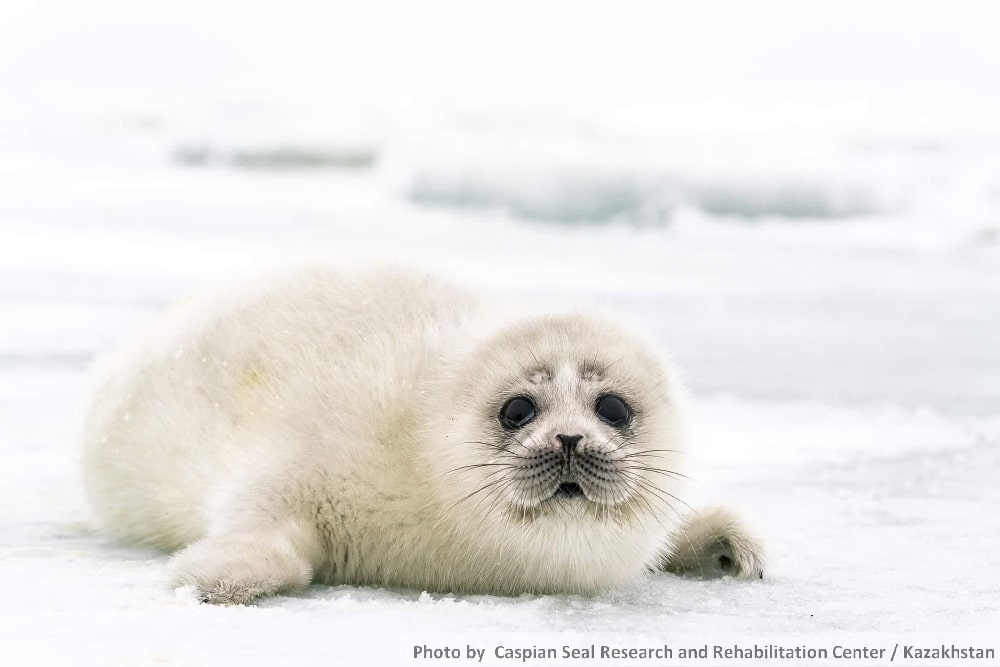
Other endemic mammals in the Caspian Sea region include the extinct Caspian Tiger (Panthera tigris virgata), Caspian Red Deer (Cervus elaphus maral), Caspian Brown Bear (Ursus arctos isabellinus), Caspian Snow Leopard (Panthera uncia), Caspian Leopard (Panthera pardus ciscaucasica), Caspian Roe Deer (Capreolus capreolus sarae), Caspian Fox (Vulpes vulpes cascadensis), Caspian Red Fox (Vulpes vulpes kopetdaghensis), Caspian Wildcat (Felis silvestris caucasica), Caspian Lynx (Lynx lynx dinniki), Caspian Mouflon (Ovis orientalis gmelini), Caspian Mole (Talpa levantis), and Caspian Squirrel (Sciurus anomalus), Caucasian Tur (Capra caucasica).
Endemic birds in the region include Caspian Plover (Charadrius asiaticus), Caspian Tit (Poecile hyrcanus), Caspian Snowcock (Tetraogallus caspius), Caspian Gull (Larus cachinnans), Caspian Tern (Hydroprogne caspia), Caspian Reed Warbler (Acrocephalus fuscus), Caspian Whistling Thrush (Myophonus caspius), Caspian Green Woodpecker (Picus viridis caspius), Caspian Tit-Warbler (Leptopoecile sophiae), Caspian Chiffchaff (Phylloscopus sindianus), and Caspian Partridge (Alectoris chukar caspius).
Learn More about the Caspian Sea
The Caspian Sea is one of the landmarks in West Asia and contains precious natural resources including 137.5 billion barrels of crude oil. It is threatened by pollution because of oil extraction and refining and other industrial endeavors such as nuclear power plants. Therefore, All neighboring countries must strive to preserve this natural gift, which is home to many endangered animal and plant species. The best way to achieve this goal is by raising awareness about the potential value of the Caspian Sea.
Where is the Caspian Sea?
The Caspian Sea is located in the north of Iran, to the east of the Caucasus Mountains, and the west of the vast steppe of Central Asia.
Frequently Asked Questions about the Caspian Sea
If you have any other questions about the Caspian Sea, its map, or other related topics, please let us know in the comments. We will respond as soon as possible.
What countries border the Caspian Sea?
The Caspian Sea is bordered by five countries: Kazakhstan, Turkmenistan, Iran, Azerbaijan, and Russia.
What is unique about the Caspian Sea?
The Caspian Sea is the largest inland body of water and is technically a lake. There are many endemic plant and animal species native to this region that make it a unique biome.
What is the main source of freshwater inflow to the Caspian Sea?
The Volga River is the main source of freshwater, providing 80% of the water to the Caspian Sea.
What is the most important natural resource in the Caspian Sea?
The Caspian Sea has a crude oil reserve of 137.5 billion barrels, making it a vital source of crude oil for the regional countries.






